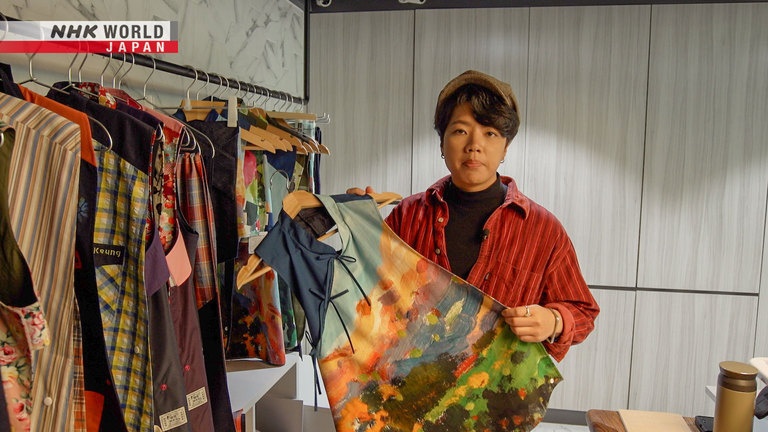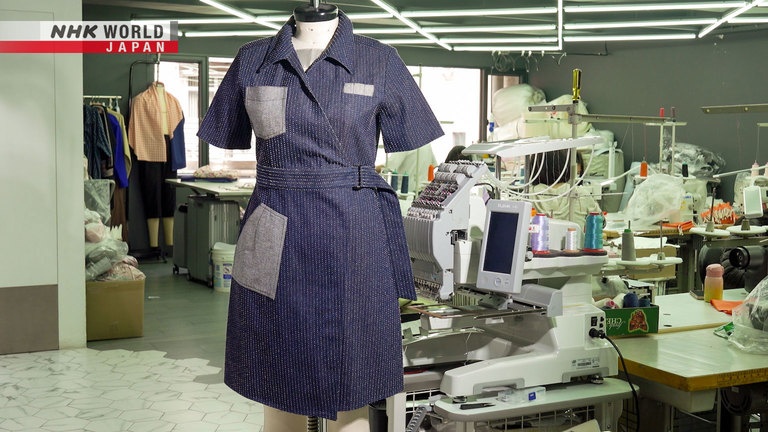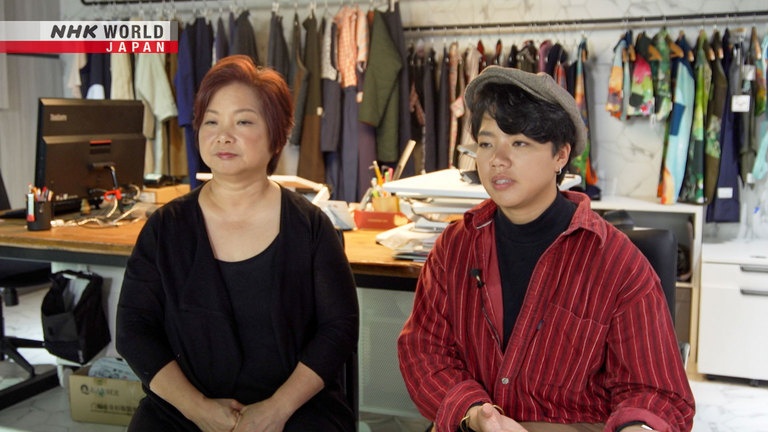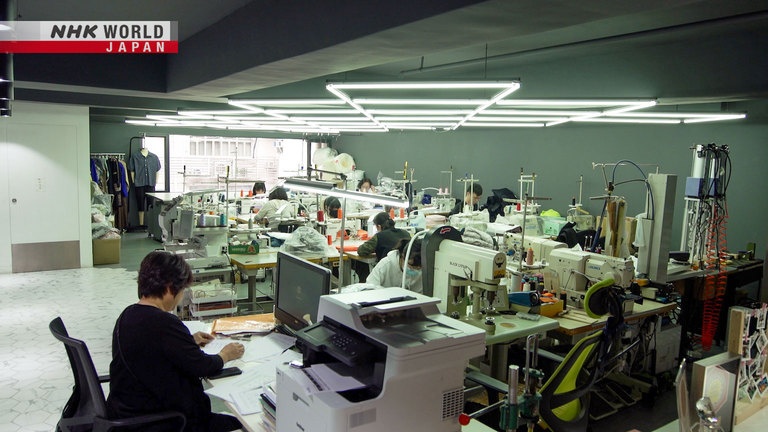Adaptive Fashion for Everyone: Kadri Keung / Fashion Designer
We take a look at a fashion designer, Kadri Keung in Hong Kong, who is revolutionizing fashion by creating clothing specifically for the elderly and people with disabilities.




Transcript
Direct Talk
China's population is rapidly aging,
and the situation in Hong Kong is serious.
Hong Kong
One woman is confronting the problem head on,
from a fashion perspective.
Designer, Kadri Keung.
She is not interested
in the latest fashion trends;
her focus is fashion for the elderly
and people with disabilities.
This work landed her on the BBC's list
of 100 inspiring and influential women
from around the world in 2022.
We feel that every single garment we make
have a great impact to
not just the user, but also the whole family.
Kadri has taken on the challenge
of creating a world
where everyone everywhere can live
with the freedom to wear clothes they like.
Hi, guys. I'm Kadri.
So, this is Rhys Workshop.
We found Rhys Workshop
with my mother in 2018.
So we are a studio in Hong Kong
locally made adaptive wear
and inclusive fashion
for elderly and disabled.
All our designs are all here.
It was a personal conundrum
that spurred Kadri to start the company.
Actually the first items we make
is the bib, and now we call it scarf.
At first glance,
it looks like a stylish garment,
but it is a bib designed
especially for the elderly.
It incorporates many innovations.
The neck utilizes Velcro
for ease of wear and removal.
The sides have snap fasteners,
which turns the "scarf" into a pocket
that catches any food
that spills while eating.
The scarf functions not only as an apron,
but a fashion item that both
the elderly and their families can enjoy.
Kadri was born and raised in Hong Kong.
Her mother worked at a garment factory.
When I was young, I would go to work
with my mother, like when I was in holiday,
then my mother would bring me to her office,
and she would tell me about like,
things happen and work
and what's the design of the garment
and how the workmanship stuff, etc. and
and, I think it might like
brought something in my heart
and bring that out.
So actually, what garment making is.
And when I was in college,
I take fashion design,
and,
I'm quite different from my classmates.
Like they are very into those
high fashion stuff of Yohji Yamamoto, KENZO.
They follow all the news,
all the latest updates
of the big brands in the world
and the designers.
But I'm actually not
quite interested in that
and I'm not so sure why I feel quite
not myself in this fashion industry.
And I find that
oh, what's the point like making stuff
that will be outdated in just few months.
And just like cycle that just like
a very busy cycle, but for nothing.
That's what I thought when I was in college.
And we also have a storage bag
for some medical accessories.
The bag was designed
to hold a urine collection bag.
With this, people can go out without
worrying about who might see them.
Actually that's every item,
we've made is there is a story behind
and mostly generate from the story that,
from the caregiving experience
with my grandmother.
Kadri started the company in 2018
with her mother, Ophelia.
Ophelia is an expert in the fashion industry,
having successfully steered a garment factory
she was managing through
various ups and downs.
It's important to understand
why we set up this fashion studio.
Soon after I retired, my mom
was admitted to a nursing care facility,
and she passed away 16 months later.
During that time,
I went to visit her every day.
I was shocked that
there were no waterproof bibs
or easy-to-wear clothes for the elderly.
I had to take time off work
to take my mother out to yum cha every week.
She liked to look pretty,
but she also ate so messily.
She would make a mess of herself.
She hated taking her bib with her
when she went out, but we had no choice.
It was very difficult for me, too,
as she insisted to wear
down jackets that were easily dirtied.
There were few bibs and clothes available
to choose from anywhere.
Then she thinks, oh, maybe we should do
something about it with our expertise.
Because I was a designer and she managed
garments manufacturing for so many years.
Why can't we do something like that?
Because it's very well
that someone would be with
that professional knowledge
and then be willing to do things for them.
So that's why we start our studio here.
And their collaboration began
to draw attention.
Of Hong Kong's current
population of 7.5 million people,
about 30 percent are over 65.
It is one of the world's
fastest greying areas.
Terms like "barrier-free" and
"universal design" are common today,
but "adaptive design" for the elderly
is still relatively unknown.
Kadri wanted to shine
a spotlight on the issue.
Suspicious of the latest fashion trends,
she turned her focus to adaptive design
and felt she could find value
in what she was doing.
Through much trial and error,
she created a number of products that
brought increasing delight to elderly people.
One incident convinced her
that she was on the right track
and that her business would find
global acceptance and understanding.
It happened on a visit Japan –
one of the leading countries in nursing care.
Because in our mind, in Japan,
the elderly care is very good,
so much better than Hong Kong.
But then we found oh, but still they
don't have a good quality of adaptive wear.
I only found two bibs,
and they were not really all that pretty.
There were not enough of
these sort of products anywhere in the world.
So that's what even more
encourage us to do what we do.
Kadri went a step further and also began
making garments for people with disabilities.
She designed and made this dress
for a woman who uses a wheelchair.
It opens at the front to allow the wearer
to don and doff the dress herself.
The back is designed like
pants and the hem is shorter
so as not to get caught
in the chair's wheels.
When we start, of course, we,
our first in our mind is the elderly,
but then we meet other customers
and we receive many feedbacks
and oh, actually there's a lot of
disabled person like not elderly,
but they are also physically challenged.
So can you do things for them?
Like, we said, why not?
Because we are here for anyone who can't find
clothes for themself in the general market.
We are dedicated to do things for them.
So, we are open for that and
we decided we want to do something
for the disabled, right?
And then, but
for elderly, we have some knowledge like
because we took care of my grandmother,
but for the disabled person,
we have no experience of that at all.
And then we did something, was
that we make an online shout out,
like we make it on our Facebook,
we post the post that up.
So, we receive one
message from a disabled girl.
She was our first project and till now
is the most significant project for us
because we designed three or four.
Four styles for her and
a dungarees, denim,
a one-piece skirt, and one-piece dress.
And for that dress is the most important item
because once we finished the dress,
she told us actually tomorrow
was her brother's wedding.
So she can wear that dress in the wedding.
So she is over-the-moon
because she doesn't want to push us.
So she never told us about that.
But then we make it.
And she told me, so we were so happy.
This opened her eyes
to the potential of adaptive wear,
and it became an important pillar
in her business.
For physically challenged,
we, our solution for now is like
customizing clothing for them.
Because we want that garments
to be really, really, really suitable,
suitable for their conditions
and be really useful for them.
Of course, we hope to like we can cater
more people,
more disabled person like in future.
Kadri wants to spread
the word about their work,
so she holds workshops and other events
in collaboration with corporations,
non-government organizations,
and universities.
The difficulty is the education like
not much people are aware of what we did.
No one's really pay attention, not much
people pay attentions to their clothing.
So one of our difficulties is
this problem is not well known to the public
and no one knows there
is a solution for that actually.
They might think there is a problem,
but they don't know what is the solution
because not much people are working on that.
They don't know where to find it.
In the future,
we would like to promote more on
how designs, how inclusive designs
can shape our society
and we would want the public
to know more about
inclusive is actually
in all aspects of our lives
and clothing is actually a big part of it.
And actually, the right, the ability to
choose what you want to wear every single day
is actually a big part of your humanity
and your self-confidence,
the source of the self-esteem.
We hope that we can expand
this ideology outside Hong Kong,
because this, actually this kind of
inclusive design is also universal
to do to every single countries
and every single elderly.
In a rapidly aging world,
Kadri aspires to see
adaptive fashion universally recognized
as fashion that symbolizes freedom.
And, Kadri's motto?
Be kind and be curious.
I think curiosity is very important to
be attentive to others to
what's happening in the society
and what's happening in the environment.
And to keep a kind heart to, so that you can
do something good to the people around you
and to give something back
to the societies that I grew up with
and so this is a very important motto
for me to keep myself moving
and improve myself every single day.